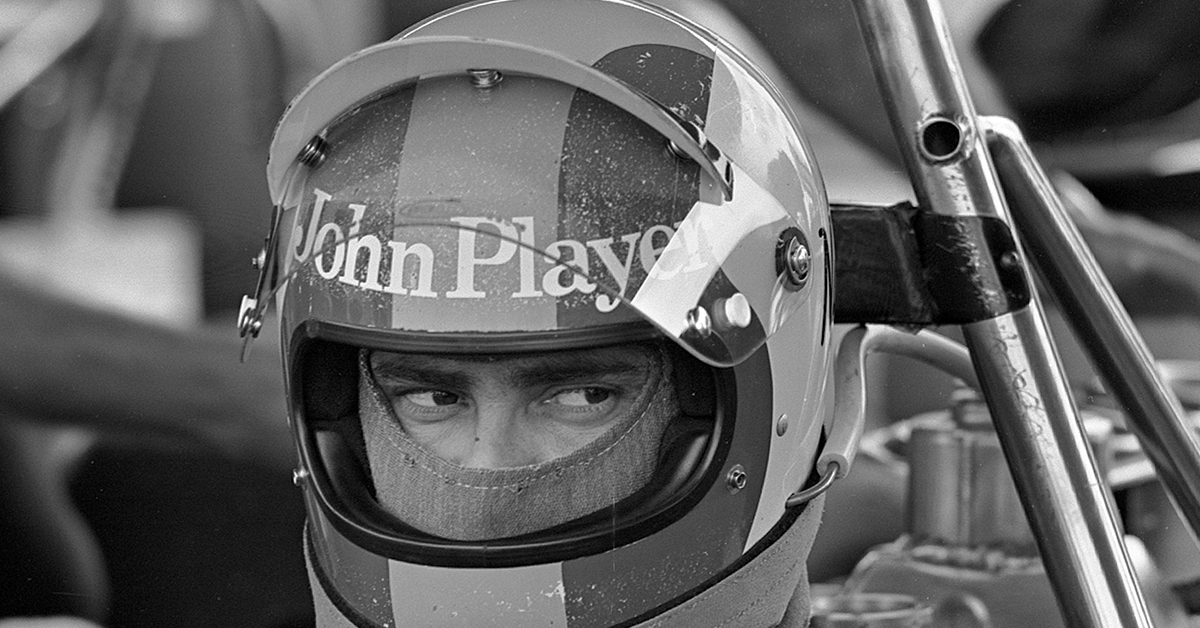
Gerry Johansson: Gunnar Nilsson, JPS Lotus 77, Formel 1, Anderstorp 1976
Gerry Johansson – A focus on racing
Sidan uppdaterades: 15 maj 2023
If you’re familiar with Gerry Johansson’s photography, you will probably recognise the desolate urban and rural landscapes, with a bare minimum of details and people. The settings can be both timeless and eventless in themselves, but after passing through Johansson’s camera lens, the motifs are nonetheless dramatic, simply because he succeeds in playing down the drama.
Johansson uses black-and-white film and infinite grey scales. His projects take a long time to complete and are carried out all over the world, from the USA, Germany and Italy to Mongolia, Japan and the Antarctica. As a rule, the name of the place that is subtly portrayed provides the title for his picture. He has also photographed Sweden; the book with the same title includes pictures of Swedish communities taken in 1988–2005, focusing on smaller places, modestly arranged in alphabetical order.
Back in the mid-1950s, when Gerry Johansson was around ten years old, he began photographing the model airplanes he built, documenting them before they inevitably crashed. This led to an interest in photography, and he joined local photo clubs and participated in photo competitions; in 1961, at 16, he became the Swedish school champion of colour photography. The following year, he stayed with relatives outside New York and joined The Village Camera Club in New York. After returning from the USA, he studied advertising and graphic design for four years at the HDK School of Design and Crafts in Gothenburg. His interest in photography per se, and not just the motifs, had grown, especially after his contacts with international photography, and his studies in graphic design resulted in a keen sense of form and composition. Altogether, this gave rise to the stringent and terse black-and-white pictures that have made him famous in Sweden and abroad; they have been published in numerous books and featured in even more exhibitions all over Europe and beyond.
A less well-known and rarely shown aspect of Gerry Johansson’s practice is his racing photos, even though his passion for, and photography of, motor sports began in his early youth. In the mid-1960s, he was a freelance photographer for several Swedish motor magazines, including Illustrerad Motorsport, Motoraktuellt and Teknik för Alla. He and the motor sports journalist Sven Berggren published the yearbooks Race 74/75 and Race 75/76 in the mid-1970s. His enthusiasm did not stop at documenting motor sport and its universe. Up until the mid-1970s, Johansson participated in races and rallies with a Saab Sport, and was district champion for the Southern Malmö Region once.
Gerry Johansson’s racing photographs have not been published separately before, but he shares pictures from legendary races online, Formula-1 images from famous tracks such as Brands Hatch, Monaco and Anderstorp, along with photos from races at all over Sweden, on his website dedicated to these images, racepace.se.
In the exhibition Pit Stop we have the pleasure of presenting a selection of Johansson’s photographs from Formula 1, 2 and 3 races in the 1960s and 1970s. We are in the middle of the action; at the time, pit stops and the area around the tracks were easy to access, and with a camera you could get even closer, regardless of whether you were there on an assignment or just a racing fan. The fact that Gerry Johansson also worked as a press photographer is obvious, but several of his pictures point to a different visual creativity. Alongside images from the track, he portrays details of tools, tyres and cars, but also of activities at the pit stop and expressive portraits of drivers and other key figures. Behind the helmet visors, we see the focused eyes of people such as the Swedes Gunnar Nilsson and Ronnie Peterson, along with several international stars. These include Brazilian Carlos Pace and the three-time F1 world champions Jack Brabham from Australia and Austrian Niki Lauda, all sharing the same tense gaze. All these pictures are characterised by an air of excitement and the almost tangible smell of oil and rubber tyres.
We are also delighted to show some of Johansson’s early motor sports images from 1964 and 1965, which were not printed until a few years later for a photography competition, where he won a silver award. These photographs, featuring, among others, the legendary Picko Troberg in a Brabham BT15, have a strongly graphic style that reveals his background in advertising and graphic design. These pictures are now in the Moderna Museet collection.
Last but not least, it is especially delightful that the exhibition theme could be complemented by the generous loan of a veteran car by Per Hågeman. This is a SWEBE from 1948, the year the first competition called Formula 1 was held in Pau, France. It is one of a handful built by Ronnie Peterson’s father Bengt and Svenne “Bergvägg” Andersson, a top racing driver in 1947 – 1966. This car may look like a museum object, but it was used in a race in Denmark as recently as in summer 2022. Through Gerry Johansson’s camera lens, we invite you to a pit stop that takes us back to Sweden’s golden age of Formula racing!
Ulrika Levén, curator Konsthall 16
Sidan publicerades: 15 maj 2023
